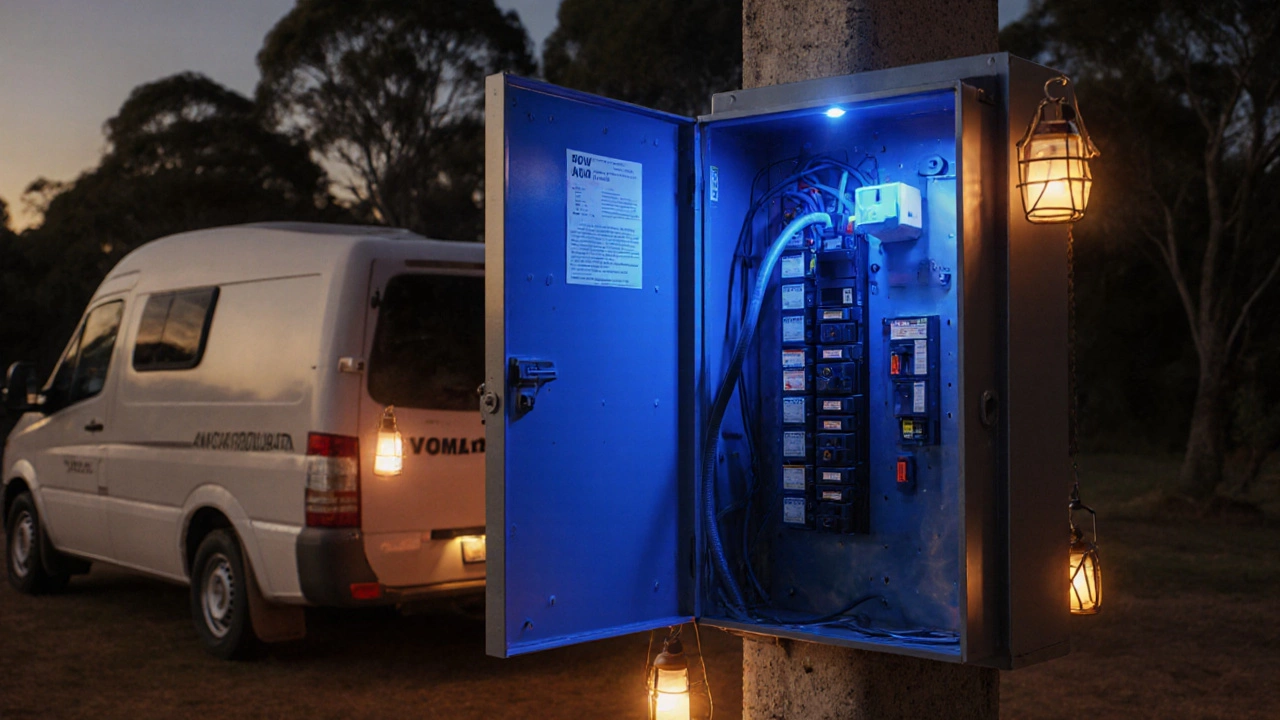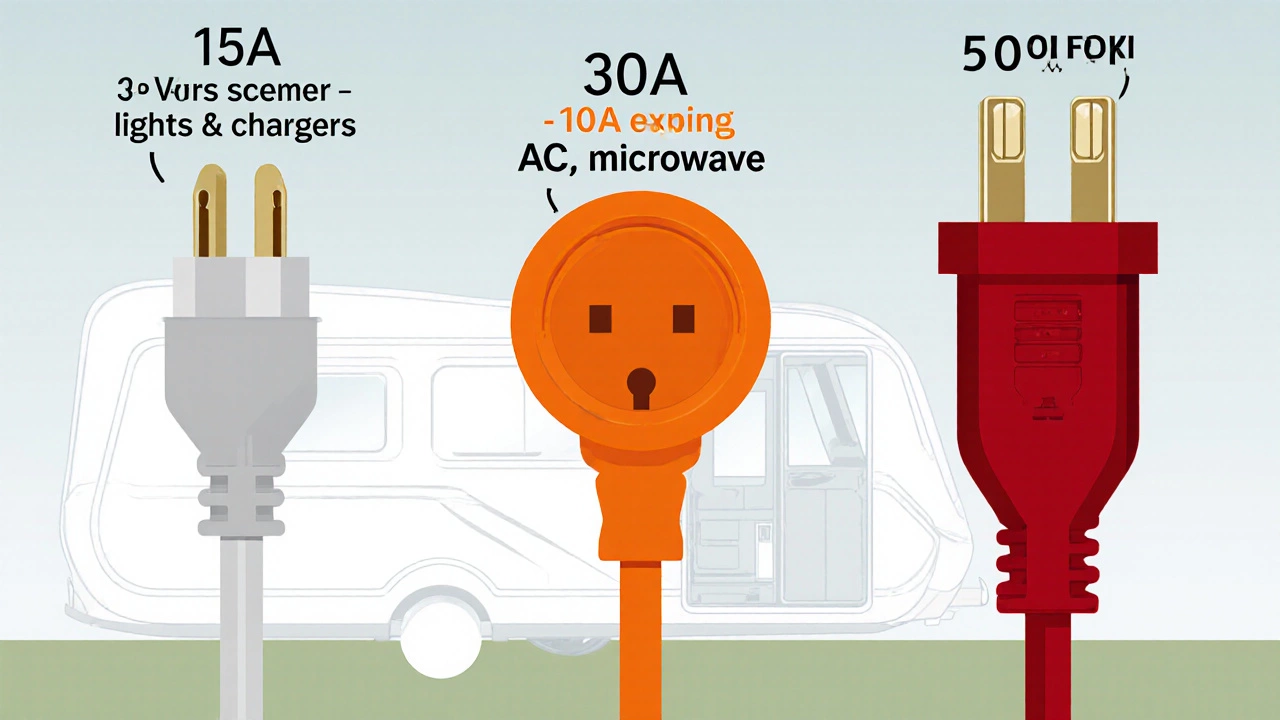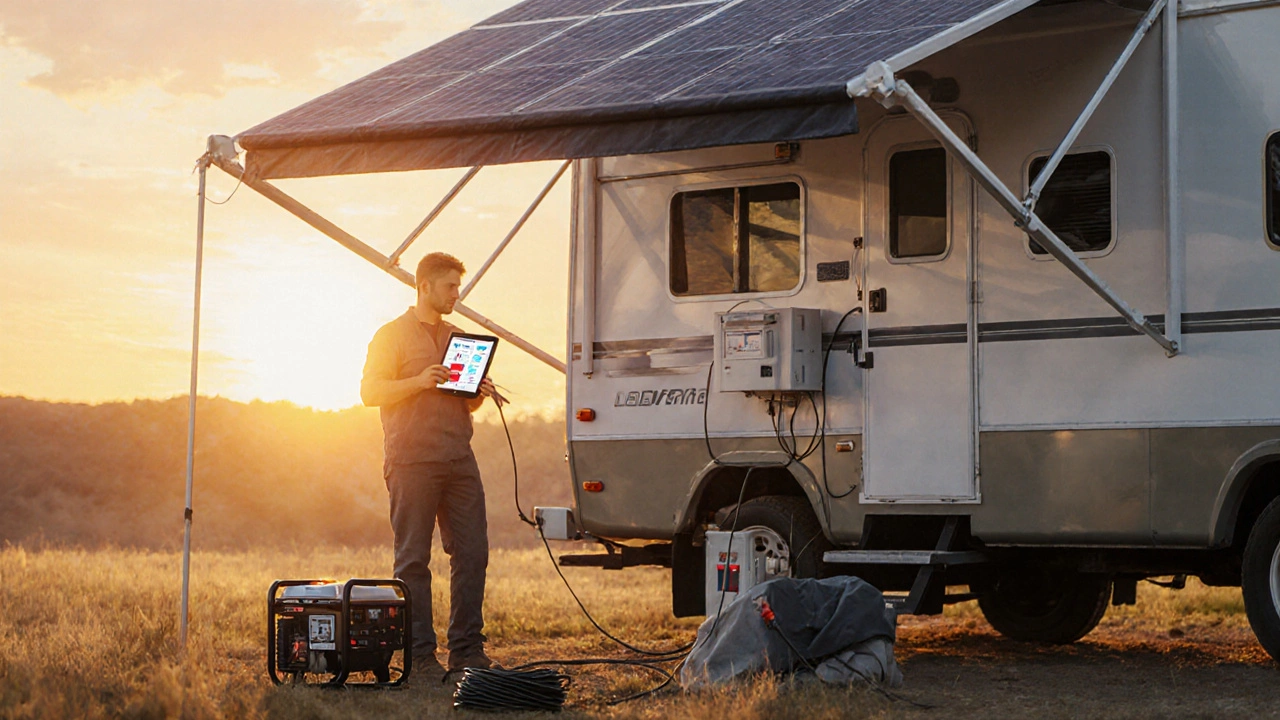How Does Electricity Work at Campsites? A Practical Guide
 Oct, 8 2025
Oct, 8 2025
Campsite Electrical Load Calculator
Enter the wattage of each appliance you plan to use simultaneously. The calculator will convert to amps and show if your total load is within safe limits for your campsite's amperage rating.
Load Summary
For a -amp site:
Total Load: amps
Safe Limit (80%): amps
Most campers assume the power socket at a site just works like the one at home, but the reality is a bit more layered. Understanding campsite electricity helps you avoid blown fuses, keep devices running, and enjoy a safe, comfortable stay.
Key Takeaways
- Australian campsites typically supply 240V AC at 30A or 50A; know what your vehicle needs.
- Three main hookup types exist: standard plug, 30‑amp, and 50‑amp connections.
- Generators and solar panels are viable backups, but each has specific wiring and safety rules.
- Use GFCI outlets, proper extension cords, and a load calculator to prevent overloads.
- Troubleshoot common issues with a systematic check of breakers, cords, and connections.
What Powers a Campsite?
At its core, a campsite draws power from the local utility grid. The grid feeds a power distribution board a metal box that splits the incoming electricity into multiple sockets for each site. In Australia, the standard is 240V single‑phase AC, delivered at either 30A or 50A depending on the site's classification.
These numbers aren’t arbitrary; they align with the national wiring rule AS/NZS3000, which defines safe installation practices for camping parks. The board also houses a circuit breaker an automatic switch that trips when current exceeds safe limits, protecting both the site’s wiring and your equipment.
Understanding Hook‑Up Types
Most caravans and motorhomes (commonly called RV a vehicle equipped for living on the road, often with built-in electrical systems) use one of three connectors:
- Standard 15‑amp plug - The same three‑pin plug you see on residential walls. Suitable for small caravans or for running low‑draw appliances like lights and phone chargers.
- 30‑amp (10‑pin) socket - Supplies up to 30A at 240V, enough for most mid‑size motorhomes, air‑conditioners, and microwaves.
- 50‑amp (15‑pin) socket - Delivers up to 50A, ideal for large luxury RVs with multiple AC units, large refrigerators, and high‑power entertainment systems.
Before you arrive, check the campsite’s site map or call ahead to confirm the available amperage. Plugging a 50‑amp vehicle into a 30‑amp site can overload the circuit, while using a 15‑amp plug for a 50‑amp load will simply trip the breaker.

Backup Power: Generators
A generator a portable engine that converts fuel into electrical energy, typically providing 120V or 240V AC is the go‑to solution when a site’s power is down or when you camp off‑grid. When choosing a generator, consider:
- Power rating - match the generator’s wattage to your RV’s peak demand (most mid‑size RVs need 3000‑4000W, while large rigs can require 6000W or more).
- Fuel type - gasoline, diesel, or propane. Diesel often runs longer and is more fuel‑efficient.
- Noise level - look for decibel ratings below 70dB to stay campsite‑friendly.
Connect the generator to your RV through a proper inverter a device that converts DC electricity from batteries or solar panels into stable AC power if you need clean, surge‑protected power for sensitive electronics.
Going Green: Solar Panels and Battery Packs
Solar energy is becoming a popular off‑grid solution. A typical solar panel a flat device that converts sunlight into direct current (DC) electricity array, paired with a battery pack a storage system that holds DC power for use when the sun isn’t shining, can sustain lights, phone charging, and even a small fridge.
Key considerations:
- Panel wattage - a 200W panel produces roughly 800Wh per day in bright conditions.
- Battery capacity - measured in amp‑hours (Ah); a 100Ah 12V battery stores about 1200Wh.
- Charge controller - regulates the flow of electricity to prevent over‑charging the batteries.
Remember, solar setups still need a 240V AC inverter if you plan to plug into the campsite’s grid sockets.
Safety First: GFCI Outlets and Proper Cords
Campground electricity can be exposed to moisture, so a GFCI outlet a ground‑fault circuit interrupter that cuts power within milliseconds if a leak to ground is detected, protecting users from electric shock is mandatory at most sites. Test the GFCI before plugging in high‑draw devices.
When you need to extend reach, use an outdoor‑rated extension cord a heavy‑gauge cable designed for outdoor use, typically rated at 12AWG for 30A loads. Never substitute a thin indoor cord; it can overheat and cause fires.
Managing Your Power Load
Overloading is the most common cause of tripped breakers. Start by calculating your total draw:
- List every appliance you’ll run (e.g., air‑conditioner 1500W, microwave 1200W, LED lights 100W).
- Convert watts to amps using the formula amps = watts ÷ voltage. For a 240V system, a 1500W AC draws 6.25A.
- Sum the amps and ensure the total stays below 80% of the site’s rating (e.g., 24A for a 30‑amp site).
A load calculator a simple spreadsheet or phone app that helps you total amperage and spot potential overloads can make this process painless.

Common Issues and Quick Fixes
Even with careful planning, things can go wrong. Here’s a quick troubleshoot guide:
- Breaker trips immediately - Check for a short circuit or a device drawing more than its rated current. Unplug all appliances, reset the breaker, then plug devices back in one at a time.
- No power at the site - Verify the campsite’s main supply isn’t down (ask the site manager). Ensure your own plug is fully seated and the GFCI test button clicks.
- Flickering lights - Likely an overloaded circuit. Reduce load or move high‑draw items to a separate outlet.
- Generator hums but no output - Check the fuel level, oil, and that the circuit breaker on the generator is ON. Also, confirm the generator’s output matches your RV’s input voltage.
Comparison of Main Hook‑Up Options
| Connector | Max Amp | Typical Use | Pros | Cons |
|---|---|---|---|---|
| 15‑amp plug | 15A | Small caravans, basic lighting | Widely available, simple | Not enough for AC or large appliances |
| 30‑amp (10‑pin) | 30A | Mid‑size motorhomes, single AC unit | Balanced power, common in Aussie parks | May require adapters for 15‑amp gear |
| 50‑amp (15‑pin) | 50A | Luxury RVs, multiple AC units | Handles high‑draw loads comfortably | Less common, requires heavier cords |
| Generator | Varies (up to 60A) | Off‑grid or emergency | Portable, independent of site supply | Fuel cost, noise, maintenance |
| Solar + Battery | Depends on system size | Eco‑friendly, silent | Zero fuel, low operating cost | Initial expense, limited power |
Next Steps for a Smooth Power Experience
1. Check your RV’s plug type and match it to the campsite’s available amperage.
2. Calculate your load using a load calculator before you leave.
3. Pack a GFCI‑tested extension cord and a portable surge protector.
4. If you rely on a generator or solar, bring spare fuel, maintenance tools, and a charge controller.
5. Arrive early, do a quick visual inspection of the site’s power board, and test the GFCI outlet.
Frequently Asked Questions
What voltage do Australian campsites use?
All standard Aussie campsites supply 240V single‑phase AC. This matches household outlets and most RV systems.
Can I use a 15‑amp plug on a 30‑amp site?
Yes, a 15‑amp plug will fit a 30‑amp socket, but it will limit you to 15A of draw. Anything bigger will trip the site’s breaker.
Do I need a special adapter for a 50‑amp RV?
Most Aussie parks provide 50‑amp (15‑pin) outlets directly. If only a 30‑amp socket is available, you’ll need a high‑quality 50‑to‑30A adapter and must stay under 30A total load.
How often should I test the GFCI outlet?
Press the "Test" button on the GFCI at each site arrival. If it trips, press "Reset" and verify power returns. Do this before plugging anything valuable in.
Is solar power enough for an air‑conditioner?
A typical RV AC draws 1500‑2000W. To run it solely on solar you’d need a 500‑W panel array plus a large battery bank (2000Wh or more) and a robust inverter. Most campers use solar for lights and gadgets, keeping the AC on grid power.